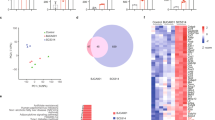Abstract
Background
Monoclonal (mAbKT) and recombinant single-chain (scFvKT) anti-idiotypic antibodies were produced to represent the internal image of a yeast killer toxin (KT) characterized by a wide spectrum of antimicrobial activity, including Gram-positive cocci. Pathogenic eukaryotic and prokaryotic microorganisms, such as Candida albicans, Pneumocystis carinii, and a multidrug-resistant strain of Mycobacterium tuberculosis, presenting specific, although yet undefined, KT-cell wall receptors (KTR), have proven to be killed in vitro by mAbKT and scFvKT. mAbKT and scFvKT exert a therapeutic effect in vivo in experimental models of candidiasis and pneumocystosis by mimicking the functional activity of protective antibodies naturally produced in humans against KTR of infecting microorganisms. The swelling tide of concern over increasing bacterial resistance to antibiotic drugs gives the impetus to develop new therapeutic compounds against microbial threat. Thus, the in vitro bactericidal activity of mAbKT and scFvKT against gram-positive, drug-resistant cocci of major epidemiologial interest was investigated.
Materials and Methods
mAbKT and scFvKT generated by hybridoma and DNA recombinant technology from the spleen lymphocytes of mice immunized with a KT-neutralizing monoclonal antibody (mAb KT4) were used in a conventional colony forming unit (CFU) assay to determine, from a qualitative point of view, their bactericidal activity against Staphylococcus aureus, S. haemolyticus, Enterococcus faecalis, E. faecium, and Streptococcus pneumoniae strains. These bacterial strains are characterized by different patterns of resistance to antibiotics, including methicillin, vancomycin, and penicillin.
Results
According to the experimental conditions adopted, no bacterial isolate proved to be resistant to the activity of mAbKT and scFvKT.
Conclusions
scFvKT exerted a microbicidal activity against multidrug resistant bacteria, which may represent the basis for the drug modeling of new antibiotics with broad antibacterial spectra to tackle the emergence of microbial resistance.

Similar content being viewed by others
References
Kunin CM. (1993) Resistance to antimicrobial drugs—a worldwide calamity. Ann. Int. Med. 118: 557–561.
Tomasz A. (1994) Multiple antibiotic-resistant pathogenic bacteria. A report on the Rockfeller University workshop. N. Engl. J. Med. 330: 1247–1251.
Gold HS, Moellering RC. (1996) Antimicrobial drug-resistance. N. Engl. J. Med. 335: 1445–1453.
Cohen ML. (1992) Epidemiology of drug resistance: implications for a post-antimicrobial era. Science 257: 1050–1055.
Hawkey PM. (1998) Action against antibiotic resistance: no time to lose. Lancet 351: 1298–1299.
Spratt BG. (1996) Antibiotic resistance: counting the cost. Curr. Biol. 6: 1219–1221.
Biörkman J, Hughes D, Andersson DI. (1998) Virulence of antibiotic-resistant Salmonella typhimurium. Proc. Natl. Acad. Sci. U.S.A. 95: 3949–3953.
Polonelli L, Morace G. (1986) Reevaluation of the yeast killer phenomenon. J. Clin. Microbiol. 24: 866–869.
Polonelli L, Conti S, Gerloni M, et al. (1991) “Antibiobodies”: antibiotic-like anti-idiotypic antibodies. J. Med. Vet. Mycol. 29: 235–242.
Polonelli L, Lorenzini R, De Bernardis F, et al. (1993) Idiotypic vaccination: immunoprotection mediated by anti-idiotypic antibodies with antibiotic activity. Scan. J. Immunol. 37: 105–110.
Polonelli L, De Bernardis F, Conti S, et al. (1994) Idiotypic intravaginal vaccination to protect against candidal vaginitis by secretory, yeast killer toxin-like antiidiotypic antibodies. J. Immunol. 152: 3175–3182.
Polonelli L, Séguy N, Conti S, et al. (1997) Monoclonal yeast killer toxin-like candidacidal anti-idiotypic antibodies. Clin. Diagn. Lab. Immunol. 4: 142–146.
Magliani W, Conti S, De Bernardis F, et al. (1997) Therapeutic potential of antiidiotypic single chain antibodies with yeast killer toxin activity. Nature Biotechnol. 15: 155–158.
Magliani W, Conti S, Gerloni M, Bertolotti D, Polonelli L. (1997) Yeast killer systems. Clin Microbiol Rev. 10: 369–400.
Conti S, Fanti F, Magliani W, et al. (1998) Mycobactericidal activity of human natural, monoclonal, and recombinant yeast killer toxin-like antibodies. J. Infect. Dis. 177: 807–811.
Séguy N, Polonelli L, Dei-Cas E, Cailliez JC. (1998) Perspectives in the control of Pneumocystis infections by using Pichia anomala killer toxinlike antiidiotypic antibodies. FEMS Immunol. Med. Microbiol. 22: 145–149.
Polonelli L, De Bernardis F, Conti S, et al. (1996) Human natural yeast killer toxin-like candidacidal antibodies. J. Immunol. 156: 1880–1885.
Polonelli L, Morace G. (1987) Production and characterization of yeast killer toxin monoclonal antibodies. J. Clin. Microbiol. 25: 460–462.
Magliani W, Polonelli L, Conti S, et al. (1998) Neonatal mouse immunity against group B streptococcal infection by maternal vaccination with recombinant antiidiotypes. Nature Med. 4: 705–709.
Moellering RC. (1998) Introduction: problems with antimicrobial resistance in gram-positive cocci. Clin. Infect. Dis. 26: 1177–1178.
Centers for Disease Control and Prevention. (1997) Update: Staphylococcus aureus with reduced susceptibility to vancomycin—United States. MMWR 46: 813–815.
Hiramatsu K, Aritaka N, Hanaki H, et al. (1997) Dissemination in Japanese hospitals of strains of Staphylococcus aureus heterogeneously resistant to vancomycin. Lancet 350: 1670–1673.
Sieradzki K, Roberts RB, Haber SW, Tomasz A. (1999) The development of vancomycin resistance in a patient with methicillin-resistant Staphylococcus aureus infection. N. Engl. J. Med. 340: 517–523.
Schwalbe RS, Stapleton JT, Gilligan PH. (1987) Emergence of vancomycin resistance in coagulase-negative staphylococci. N. Engl. J. Med. 316: 927–931.
Veach LA, Pfaller MA, Barrett M, Koontz FP, Wenzel RP. (1990) Vancomycin resistance in Staphylococcus haemolyticus causing colonization and bloodstream infection. J. Clin. Microbiol. 28: 2064–2068.
Sieradzki K, Roberts RB, Serur D, Hargrave J, Tomasz A. (1998) Recurrent peritonitis in a patient on dialysis and prophylactic vancomycin. Lancet 351: 880–881.
McMurray LW, Kernodle DS, Barg N. (1990) Characterization of a widespread strain of methicillin-susceptible Staphylococcus aureus associated with nosocomial infections. J. Infect. Dis. 162: 759–762.
Murray BE. (1997) Vancomycin-resistant enterococci. Am. J. Med. 102: 284–293.
Moellering RC. (1998) Vancomycin-resistant enterococci. Clin. Infect. Dis. 26: 1196–1199.
Moellering RC. (1991) The enterococcus: a classic example of the impact of antimicrobial resistance on therapeutic options. J. Antimicrob. Chemother. 28: 1–12.
Dutka-Malen S, Blaimont B, Wauters G, Courvalin P. (1994) Emergence of high-level resistance to glycopeptides in Enterococcus gallinarum and Enterococcus casseliflavus. Antimicrob. Agents Chemother. 38: 1675–1677.
French G, Abdulla Y, Heathcock R, Poston S, Cameron J. (1992) Vancomycin resistance in south London. Lancet 339: 818–819.
Fontana R, Ligozzi M, Pedrotti C, Padovani EM, Cornaglia G. (1997) Vancomycin-resistant Bacillus circulans carrying the vanA gene responsible for vancomycin resistance in enterococci. Eur. J. Clin. Microbiol. Infect. Dis. 16: 473–474.
Poyart C, Pierre C, Quesne G, Pron B, Berche P, Trieu-Cuot P. (1997) Emergence of vancomycin resistance in the genus Streptococcus characterization of a vanB transferable determinant in Streptococcus bovis. Antimicrob. Agents Chemother. 41: 24–29.
Tomasz A. (1997) Antibiotic resistance in Streptococcus pneumoniae. Clin. Infect. Dis. 24 (Suppl. 1): S85–88.
Novak R, Henriques B, Charpentier E, Normark S, Tuomanen E. (1999) Emergence of vancomycin tolerance in Streptococcus pneumoniae. Nature 399: 590–593.
Boman HG. (1995) Peptide antibiotics and their role in innate immunity. Annu. Rev. Immunol. 13: 61–92.
Hancock RE. (1997) Peptide antibiotics. Lancet 349: 418–422.
Lehrer RI, Lichtenstein AK, Ganz T. (1993) Defensins: antimicrobial and cytotoxic peptides of mammalian cells. Annu. Rev. Immunol. 11: 105–128.
Nicolas P, Mor A. (1994) Peptides as weapons against microorganisms in the chemical defense system of vertebrates. Annu. Rev. Microbiol. 49: 277–304.
Acknowledgments
Ministero della Sanità, Istituto Superiore di Sanità, Programma Nazionale di Ricerca sull’AIDS—1998, Accordo di Collaborazione Scientifica n. 50B.32, and Ministero dell’Università e della Ricerca Scientifica e Tecnologica, Programmi di Ricerca Scientifica di Interesse Nazionale—1999.
Author information
Authors and Affiliations
Corresponding author
Rights and permissions
About this article
Cite this article
Conti, S., Magliani, W., Arseni, S. et al. In vitro Activity of Monoclonal and Recombinant Yeast Killer Toxin-like Antibodies Against Antibiotic-resistant Gram-positive Cocci. Mol Med 6, 613–619 (2000). https://doi.org/10.1007/BF03401799
Accepted:
Published:
Issue Date:
DOI: https://doi.org/10.1007/BF03401799




